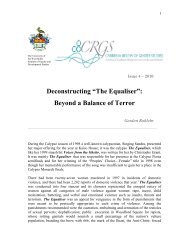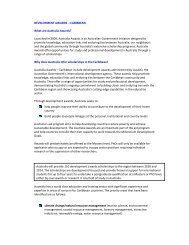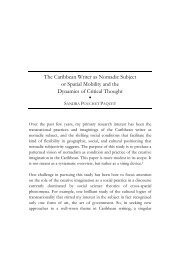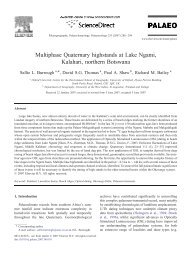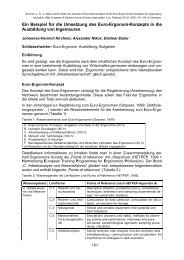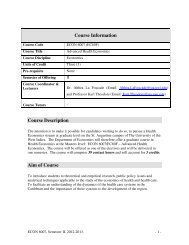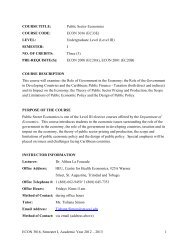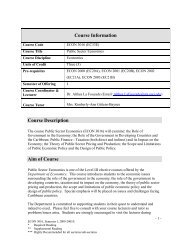Faculty of Humanities and Education (Postgraduate) - The University ...
Faculty of Humanities and Education (Postgraduate) - The University ...
Faculty of Humanities and Education (Postgraduate) - The University ...
You also want an ePaper? Increase the reach of your titles
YUMPU automatically turns print PDFs into web optimized ePapers that Google loves.
20<br />
POSTGRADUATE REGULATIONS & SYLLABUSES 2012 - 2013<br />
THE FACULTY OF HUMANITIES & EDUCATION<br />
YEAR: I<br />
SEMESTER: II<br />
COURSE CODE: CDEN 6005<br />
COURSE TITLE: DESIGN AS A STRATEGIC BUSINESS TOOL<br />
NUMBER OF CREDITS: 4<br />
COURSE DESCRIPTION: This module considers the application<br />
<strong>of</strong> design as a driver for the strategic management <strong>and</strong><br />
development <strong>of</strong> businesses. <strong>The</strong> emphasis is placed on the use<br />
<strong>of</strong> design as a tool to influence organisational change with<br />
both an internal <strong>and</strong> external business focus: the mind-set <strong>of</strong><br />
individuals within an organisation is critical for design-led<br />
success in the marketplace.<br />
In respect <strong>of</strong> the product/service/experience, students will<br />
critically appraise the development <strong>of</strong> design in its role <strong>of</strong><br />
communicating corporate identity <strong>and</strong> as an external business<br />
interface.<br />
Using amongst other sources, key case studies, students will<br />
explore the influence <strong>of</strong> design on international culture <strong>and</strong><br />
business methodologies. <strong>The</strong>y will focus on the use <strong>of</strong> design as a<br />
tool for change management <strong>and</strong> as a facilitator for behavioural<br />
change within complex product or service industries.<br />
As an outcome <strong>of</strong> this process, students will be required to make<br />
predictions concerning the future application <strong>of</strong> design within<br />
the strategic business environment.<br />
OBJECTIVES<br />
At the end <strong>of</strong> the course students will be able to:<br />
1. Evaluate critically the role <strong>of</strong> design as a strategic<br />
management tool within an organisation;<br />
2. H<strong>and</strong>le open-ended <strong>and</strong> complex issues with confidence<br />
<strong>and</strong> be able to establish own academic agenda;<br />
3. Present in the form <strong>of</strong> a case study a critical evaluation <strong>of</strong><br />
the use <strong>of</strong> design as a strategic management tool within<br />
one organisation with discussion <strong>and</strong> suggestions for its<br />
predicted use in the future;<br />
4. Apply Design Management tools <strong>and</strong> thinking to a situation<br />
to develop reasoned arguments <strong>and</strong> conclusions;<br />
5. Present thinking <strong>and</strong> conclusions in a lucid academic style.<br />
CONTENT<br />
Strategic analysis<br />
Corporate culture<br />
• Management systems <strong>and</strong> control<br />
• Perception <strong>and</strong> definition <strong>of</strong> design in the organisation<br />
• Identifying design activity within the organisation<br />
• Innovation: nurturing <strong>and</strong> managing a culture <strong>of</strong> creativity<br />
Design <strong>and</strong> corporate identity<br />
• Influence <strong>of</strong> design on international culture:the creation <strong>of</strong><br />
a national style within an international vocabulary<br />
• <strong>The</strong> rise <strong>and</strong> fall <strong>of</strong> the br<strong>and</strong>: the use <strong>of</strong> design as a<br />
vehicle<br />
• Design as a strategic tool in business-to-business <strong>and</strong><br />
business-to-consumer environments<br />
• Corporate communication: strategy, implementation,<br />
feedback<br />
Design <strong>and</strong> strategic management<br />
• Environmental assessment: identifying the position <strong>and</strong><br />
use <strong>of</strong> design by competitors<br />
• <strong>The</strong> role <strong>of</strong> design in organizational change<br />
• Measuring the success <strong>of</strong> design activities within the<br />
organisation<br />
• Change management<br />
• Linking strategic <strong>and</strong> operational change: operational<br />
issues<br />
• Design leadership<br />
Delivery<br />
Lectures, seminars, readings, discussions, workshops <strong>and</strong><br />
research will be used to deliver this course. A case study (see<br />
assessment below) will be required at the end <strong>of</strong> the semester<br />
with a formative submission <strong>of</strong> the case study pr<strong>of</strong>ile during<br />
the mid-semester period. A Design Audit <strong>and</strong> Analysis will be<br />
presented by students (approx. 15 minutes long).<br />
ASSESSMENT<br />
Case Study (4,000 words) 60%<br />
Design Audit <strong>and</strong> Analysis 40%<br />
YEAR: I<br />
SEMESTER: II<br />
COURSE CODE: CDEN 6006<br />
COURSE TITLE: STRATEGIC MARKETS FOR DESIGN IN A<br />
GLOBAL ECONOMY<br />
NUMBER OF CREDITS: 4<br />
COURSE DESCRIPTION:<br />
Overview<br />
Businesses need to utilise specialist skills to complement their<br />
technical <strong>and</strong> design abilities if they are to compete effectively<br />
within the Global Economy <strong>and</strong> this course will examine the role<br />
<strong>of</strong> the Design Entrepreneur in such an environment.<br />
<strong>The</strong> complex nature <strong>of</strong> customer needs together with global<br />
manufacturing processes, technological systems <strong>and</strong> the<br />
continuing internationalisation <strong>of</strong> markets are all factors that<br />
impact on the level <strong>of</strong> innovation within an organization/<br />
business.<br />
Innovation is the life-blood <strong>of</strong> every design-led business;<br />
however, developing <strong>and</strong> delivering new products/services to<br />
global markets is becoming increasingly complex. Constant<br />
production innovation, short life cycles <strong>and</strong> high cannibalisation<br />
rates are becoming typical for many industries in today’s global<br />
economy. Companies need to collaborate effectively, both within<br />
their own organizations <strong>and</strong> across their extended enterprise in<br />
order to compete at a level that will sustain them for the future.<br />
Students will be encouraged to appreciate that the future <strong>of</strong><br />
successful business innovations depend on delivering benefits<br />
better than competitors <strong>and</strong> learn how to identify what<br />
customers want in a global environment.







